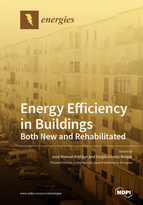Energy Efficiency in Buildings: Both New and Rehabilitated
A special issue of Energies (ISSN 1996-1073). This special issue belongs to the section "G: Energy and Buildings".
Deadline for manuscript submissions: closed (31 October 2019) | Viewed by 79480
Special Issue Editors
Interests: intelligent control; renewable energies; education in engineering
Special Issues, Collections and Topics in MDPI journals
Interests: architecture and engineering
Special Issues, Collections and Topics in MDPI journals
Special Issue Information
Dear Colleagues,
Buildings are one of the main causes of the emission of greenhouse gases in the world; in Europe, for example, they are responsible for more than 30% of emissions, or about 900 million tons of CO2 per year. Heating and air conditioning are mainly responsible for greenhouse gas emissions in buildings.
Based on the above, it is a current priority to reduce (or ideally eliminate) the waste of energy in buildings and at the same time supply the necessary energy through renewable sources. The first can be achieved by improving the construction methods, the materials used and the efficiency of the facilities and systems; the second can be achieved through the use of renewable energies (wind, solar, geothermal, etc.) in buildings. In any case, regardless of whether the energy used is renewable or not, the efficiency must always be taken into account: the most profitable and clean energy is that which is not necessary.
Most current buildings were built with poor energy efficiency criteria and even, depending on the country and the date of construction, with none. Therefore, regardless of whether construction regulations are becoming stricter, a huge challenge is the energy rehabilitation of existing buildings.
In this Special Issue, potential topics include but are not limited to the following:
- Methodologies, processes, methods to design/build/rehabilitate minimum energy consumption buildings.
- Efficient electric loads: ventilation, heating, air conditioning, lighting, domestic hot water, appliances, etc.
- Facilities in buildings for minimum energy consumption.
- Renewable energy applications in buildings.
- Maintenance and management of buildings for minimum energy consumption.
- Methods and systems of energy measurement and control in buildings.
- Home automation for energy efficiency in buildings.
Prof. Dr. José Manuel Andújar
Dr. Sergio Gómez Melgar
Guest Editors
Manuscript Submission Information
Manuscripts should be submitted online at www.mdpi.com by registering and logging in to this website. Once you are registered, click here to go to the submission form. Manuscripts can be submitted until the deadline. All submissions that pass pre-check are peer-reviewed. Accepted papers will be published continuously in the journal (as soon as accepted) and will be listed together on the special issue website. Research articles, review articles as well as short communications are invited. For planned papers, a title and short abstract (about 100 words) can be sent to the Editorial Office for announcement on this website.
Submitted manuscripts should not have been published previously, nor be under consideration for publication elsewhere (except conference proceedings papers). All manuscripts are thoroughly refereed through a single-blind peer-review process. A guide for authors and other relevant information for submission of manuscripts is available on the Instructions for Authors page. Energies is an international peer-reviewed open access semimonthly journal published by MDPI.
Please visit the Instructions for Authors page before submitting a manuscript. The Article Processing Charge (APC) for publication in this open access journal is 2600 CHF (Swiss Francs). Submitted papers should be well formatted and use good English. Authors may use MDPI's English editing service prior to publication or during author revisions.
Keywords
- energy efficiency
- passive architecture
- heating, ventilating and air conditioning
- nearly zero energy building
- renewable energy systems
- energy rehabilitation







